Do Sphynx Cats get Blackheads?
Do Sphynx Cats get Blackheads? Sphynx cats can get blackheads on their head or chin because of the oily skin. Usually, blackhead appears when they reach adolescence.
The sphynx cat has a striking appearance, wrinkled skin, and medium to large ears, along with a muscular and sleek feline body that is dense and heavy. Sphynx is a medium to large size cat breed with nicely developed muscles.
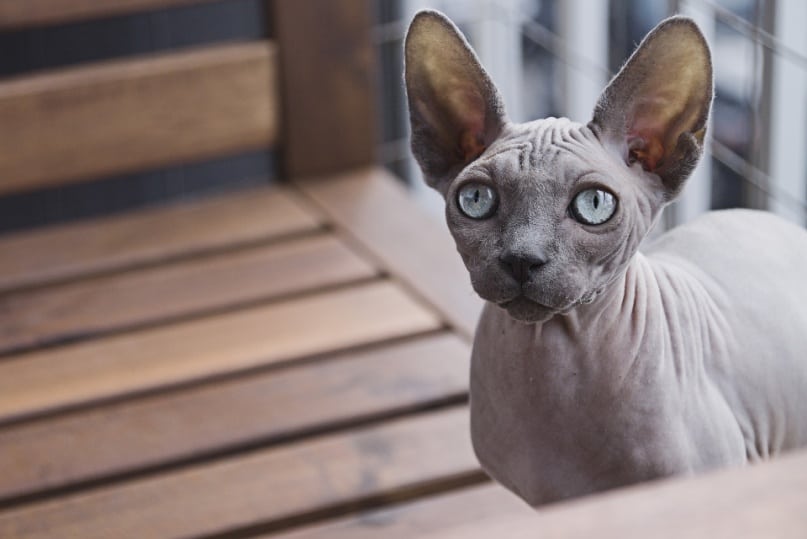 Sphynx Characteristics:
Sphynx Characteristics:
- Weight range: Female: less than 13 lbs., Male: less than 13 lbs.
- Breed Type: Medium
- Longevity Range: 9-13 yrs.
- Social/Attention Needs: Very High
- Eye colour: Varies/Multiple
- Shedding: Very low- high
Sphynx Body Coat Characteristics:
- Allergenic: Low but have sensitive skin
- Prevalence: Rare (Not common)
- Grooming Requirements: Medium-High
- Length: Short
- Coat Type: Nearly hairless, can range from peach fuzz to entirely bald
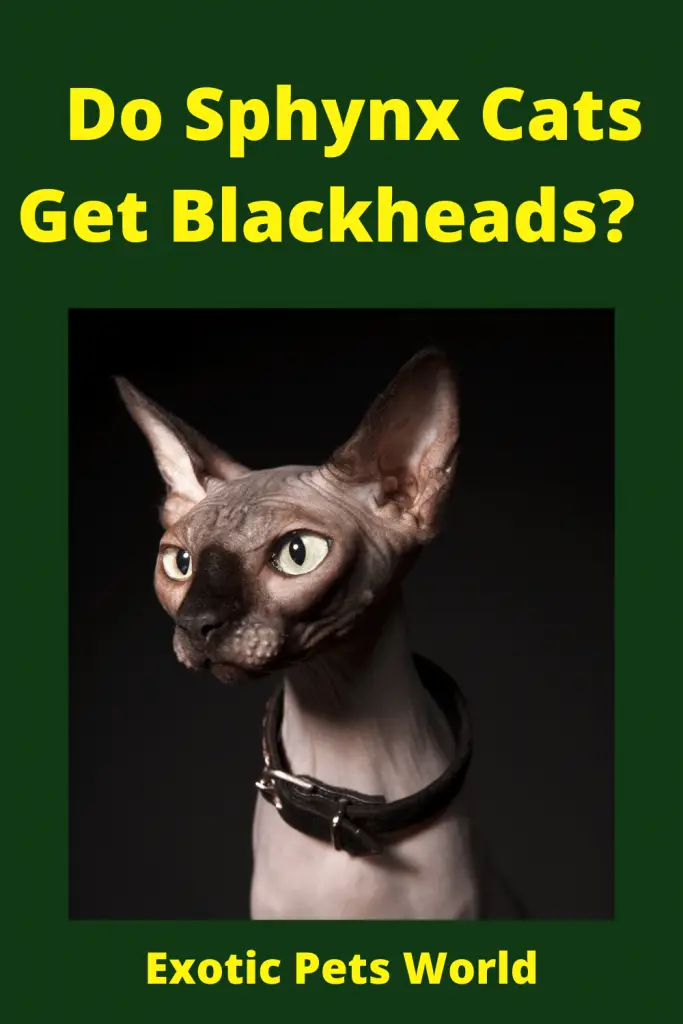
Coat Colors:
- Cream
- Blacktortoiseshell
- Red
- Blue
- Cameo
- Golden
- Blue-cream
- White
- Brown
- Silver
Sphynx Coat Pattern:
- Bicolor
- Ticking
- Tortoiseshell
- Shaded
- Tricolour/calico
- Smoke
- Tabby
- Solid color
Sphynx’s eyes are wide and sharp along with prominent cheekbones. Also, Sphynx’s head is a triangular shape that recalls old cats of ancient Egypt, a similarity that influenced the breed’s name. In addition to being hairless, the Sphynx’s most prominent feature is the blackhead’s appearance on her head and its large, triangular-shaped ears that resemble a bat.
How Do you Get Rid of Blackheads on Sphynx Cats?
To treat blackheads, rinse them with warm, lukewarm water, and mild antibacterial soap (ask your doctor for a recommendation). After that wipe with a cotton ball filled with witch hazel – but wash it off with cold water. Licking witch hazel can make them sick so take care of that your cat never licks that. Your doctor may recommend using benzoyl peroxide pads, depending on the Sphynx blackheads or acne’s severity.
The thing is, you can’t ignore blackheads. If left untreated, your cat may get swollen hair follicles, which will require medical attention.
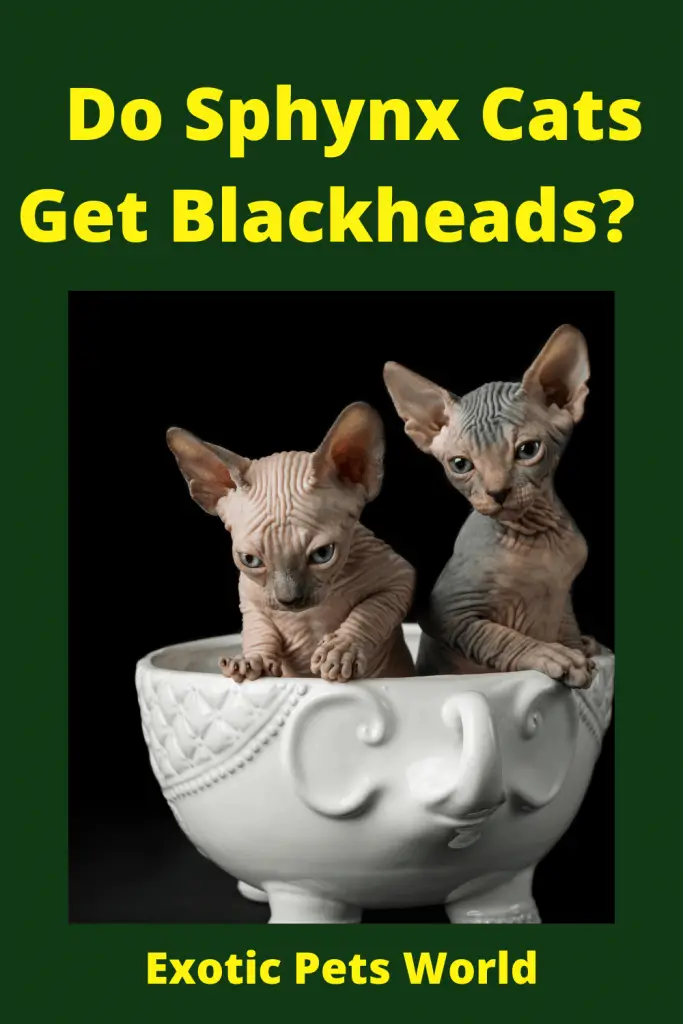
Can I Pop My Cat’s Blackheads?
Popping blackheads is the awful thing you can do. It causes a lot of pain and irritation to your felines and disturbs their hair follicles’ structure. Plus popping blackheads can extend the persistent infection to other portions of the chin, which increase the amount of blackhead on your cat.
It is always advisable to regularly consult your pet veterinarian as long as follicular acne or blackheads are present. If you do not consult your veterinarian, these blackheads can become a significant problem and spread infections to other body parts. Also, infected wounds can turn into traumatic injuries, if left untreated.
The leading cause of these blackheads is still unknown: however, plastic food/water dishes or cups are one of the primary causes of blackheads because they harbor more microbes, so we recommend that pet owners must use metal dishes and clean them daily regularly.
You must regularly visit the veterinarian because if a cat is at risk of blackheads infection, your veterinarian may want to check for other skin conditions or parasites to increase blackheads/acne.
Do Sphynx Cats Smell?
Although cats are less likely to stink because of their self-grooming habits, some breeds, such as Sphynx cats, are more prone to smell than others. Not all hairless cats stink. But because of their genes and other external factors, they may smell bad if you are not so careful.
TOP REASONS WHY YOUR HAIRLESS CAT STINKS
Almost all the cats are notoriously clean creatures. They spend most of their waking hours carefully grooming themselves, so you may be surprised to learn why Sphynxes can stink? Even after excessive grooming. As mentioned earlier, there are several causes why your hairless cat stinks.
Here are some of them:
- POOR HYGIENE
Because Sphynx cats have no fur to protect them from excess heat, they “sweat” and accumulate a layer of oily film on their skin. These greasy residues can pick up dirt, dust, and other debris, causing them to become dirty and smelly over time.
Also, they cannot clean themselves well, so they depend on their human companions for their hygiene.
- POOR DIET
The smell of your hairless cat can also be caused by what they eat. Diet plays a vital role in your cat’s health and overall wellness. In particular, the care of Sphynx cats is very high when it comes to their nutrition.
A low diet can trigger several health problems such as allergies, digestive system, ear infections, and skin problems, all of which can cause your cat to stink.
- MOUTH ISSUES
Cats can develop bad breath, just like humans do. Bad breath in cats is usually initiated by a chronic illness such as gum disease, tooth decay, or kidney disease. Bad breath can affect the quality of their saliva, causing them to stink.
When the saliva of hairless cat comes in contact with their skin, foul odor-causing bacteria can spread throughout their body while grooming themselves, causing them to become stinky.
- EAR ISSUES
Most ear infections in felines are mostly stinky with pus or wrong fluid coming out from them. If your Sphynx cat smells fetid or musty, try examining their ears. Ear mite infestations, yeast infections, and bacterial infections are some of the medical conditions which cause bad breath in Sphynx cats.
- REAR END ISSUES
Incontinence, bladder problems like urinary tract infections, or genetic anomalies in the urinary tract can also cause your Sphynx cat to smell bad. Besides, tumors and other conditions that affect your cat’s anal glands can also cause bad breath.
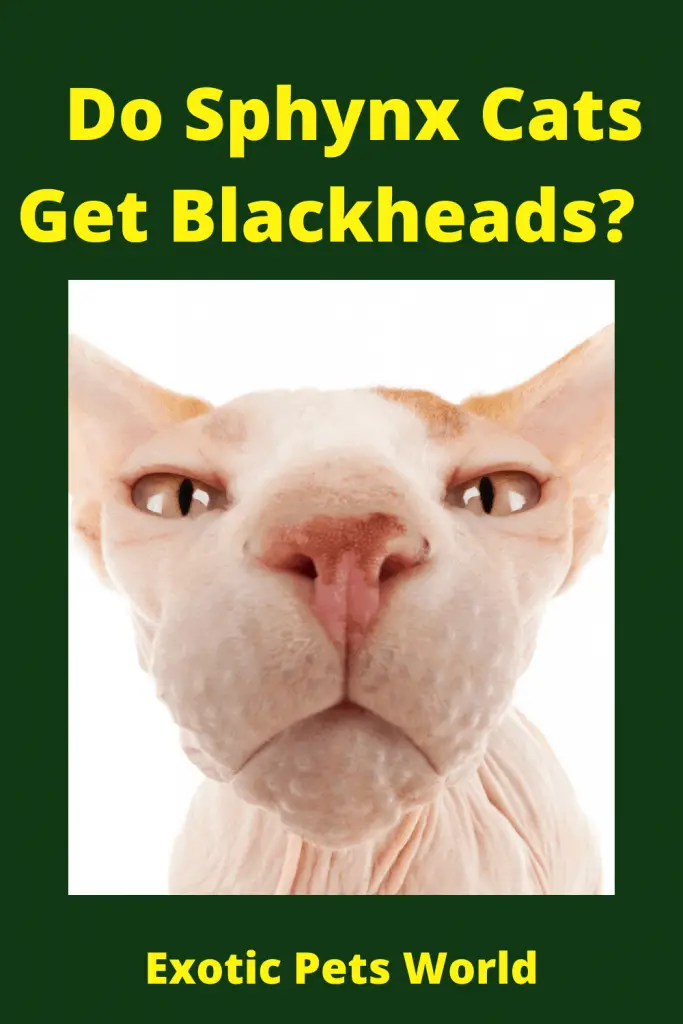
HOW TO PREVENT YOUR SPHYNX CAT FROM GETTING STINKY AND SMELLY
BATHE YOUR CAT REGULARLY
Not all hairless (Sphynx) cats get oily and stinky quickly, it is generally recommended to take maximum hygiene procedures/sessions or weekly baths. It’s best to keep your cat’s skin clean and check for dirt, which can cause redness, allergy, or a bad smell.
Even small bumps/folds on your cat’s skin should be checked regularly as dirt, and bacterial buildup can cause itch or other skin problems. It is imperious to use products only designed for Sphynx, as some other cat products can irritate their sensitive skin.
FEED YOUR CAT HIGH-QUALITY FOOD
Unlike other cats’ breeds, Sphynx cats need a special diet because they have a sensitive digestive system. People don’t realize it when they get their Sphynx cats. Ordinary cat food brands often cause inflammation in the gastrointestinal tract of hairless cats or cause a foul smell coming from their mouth.
A raw diet is recommended because it minimizes food intolerance issues in cats. It also enhances better skin health and produces less foul-smelling stool. It is crucial to eliminate all possible allergens and avoid high waste ingredients such as grains and other high carbohydrate fillers in the Sphynx diet.
Cheap cat food can fill your Sphynx’s stomach, but it will not be adequately digested and result in a horrible stinking bomb.
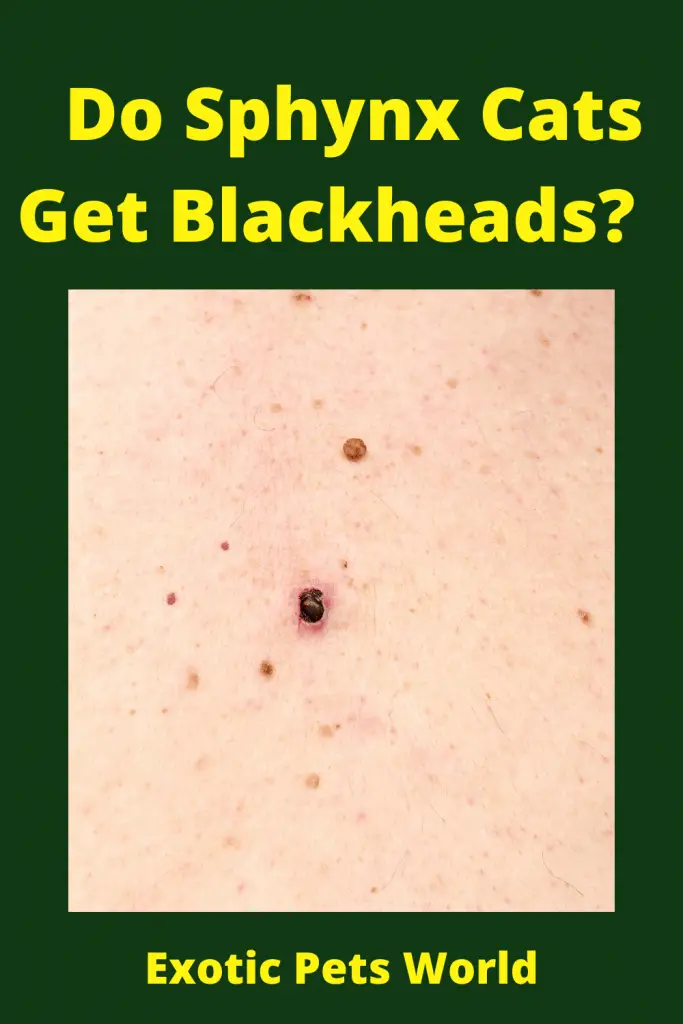
CONSIDER YOUR CAT’S DENTAL HYGIENE
Caring for a cat’s teeth is not that difficult. However, when teeth are ignored, plaque can build up quickly, causing bacteria to accumulate in your cat’s mouth. To prevent respiratory distress and plaque formation, consider starting a regular dental procedure for your cat.
A right toothbrush and toothpaste for cats are usually adequate. People often use human toothpaste in large numbers while brushing their felines which also work fine. There is a wide selection of dental cat treatments on the market today that can help your cat’s dental hygiene.
CLEAN YOUR CAT’S EARS REGULARLY
In addition to regular dental practice and bathing schedule, it is essential to clean your cat’s ears frequently. Sphynx cats have more waxy ears than most cats because they have less hair in their ears.
It means that dirt, oil, and earwax accumulate faster with fur in them than with other cats’ breeds. Ideally, pet parents need to clean their ears every week after bath time. You can use a cotton swab to clean their ears gently.
SCREEN YOUR CAT FOR POSSIBLE HEALTH PROBLEMS
Health problems such as swollen glands, skin and ear infections, kidney problems, and oral disease can all cause your sphynx cat/hairless cat to stink. Regular screening of your cat for these health conditions can prevent, or even treat, your Sphynx’s persistent bad smell.
Aside from the odor problems, Sphynx cats have become big pets. They share some of the great qualities of dogs and cats (they are great with dogs), making them excellent pets. As long as you keep them fresh, clean, and healthy, their odor will not be a big problem.
RELATED QUESTIONS
What Health Problems do Sphynx Cats Have?
Sphynx cats experience various health conditions such as urinary and respiratory problems, hereditary myopathy, hypertrophic cardiomyopathy, and sensitive digestive systems. They are also at risk of emerging infections and skin problems due to their body’s sensitive nature.
What Do Sphynx Cats Feel alike?
Contrary to popular belief, these hairless cats are not thoroughly cleansed of their hair. They have fabulous fur that makes them feel warm and touch. Some say they feel like hot peaches or hot suede leather.
Can Sphynx Cats be left Alone?
Surely not. Sphynx cat/hairless cat does not like to be alone for long. When they ignore their human parents, they often suffer from separation anxiety and depression. If you’re not at home most days, it’s a good idea to pair them with another cat.

Do Sphynx Cats get Fleas? Or Can Hairless Cats Get Fleas?
Yes. Parasites like fleas do not need hair to feed on an animal’s blood. They will associate themselves with any animal they may be, hairless or not. Hairless cats are just as sensitive to fleas as any other cat, but fleas are visible on Sphynx cats.
Acne in Sphynx Cats: What do the Black Dots on the Tail Tell You?
Often, cats also have acne. For instance, you may see black dots on the tail of a Sphynx cat. Usually, black spots on a Sphynx cat’s tail indicate improper care of the animal, but they can also be caused by developing various diseases in a male or female cat. Acne can have its effects on cats: from cosmetic defects to epidermis. The development of acne is affected by many factors. Its symptoms are just the tip of the iceberg of hidden health problems. Dark spots on the tail of a Sphynx can appear for various reasons, and only an experienced cat expert can determine if an animal needs special treatment or not. To avoid this becoming a significant problem, you should check your pet regularly for acne.
Why is Cat Acne Black?
It can be a cat’s acne, a common skin condition in cats, and it looks like a dirty chin. Cats can have mild to moderate acne. Those black spots are blackheads, which are like blackheads in humans. In more severe circumstances, a cat can develop red sores and lesions on the chin area.
Some cats have a higher risk of acne than others. It includes cats that do not look appropriately groomed, produce more sebum or keratin (Sphynx), have clogged hair follicles or are allergic. Your veterinarian can do a simple examination to diagnose acne and rule out any other skin condition.
Your doctor can clip the fur, clean the area, and then treat the condition on your cat’s chin. Treatment will continue at home, with continued use of the ointment. Hot compresses can also be helpful. If the acne has grown into an infection, antibiotics may be needed.
What Do You use on Sphynx Blackheads?
The best way to treat blackheads immediately is to take your cat to the vet if not then use your finger to gently pull them out (after soaking in the tub, or maybe after a hot compressed if it is on her chin). But if your hands are contaminated, you can spread more infection instead of curing it so try to take your affected cat to the vet as soon as possible.
Because of the Sphynx’s oily skin, they can get blackheads on their chin like teenagers. The other method to treat them is to rinse with lukewarm water, and mild antibacterial soap (ask your doctor for a recommendation) then wipe with a cotton ball filled with witch hazel. After that, wash it off with normal water.
Why Does My Sphynx Cat get Blackheads on his Chin/Tail?
Acne can be caused by excessive keratin production in the hair follicular region, i.e., follicular keratinization may occur along with secretion from the sebaceous glands. It causes a blockage of the hair follicles due to a mixture of sebum and keratin (oily secretions from the skin glands mentioned above). In cats, acne is more common around the chin, commonly called cat chin acne.
What Causes Cat Chin Acne?
The causes of cat acne are not well understood. There are several potential risk factors that have been identified:
- Stress
- Dietary intolerances
- Certain viruses
- Poor grooming around the mouth due to dental disease
- Reduced immune response
- Hyperactive sebaceous glands
Skin Health on Sphynx Cats
The Sphynx can suffer from certain skin conditions, such as urticaria pigmentosa, and cutaneous mastocytosis, as well as periodontal disease. Cats with urticaria pigmentosa have multiple, partially symmetrical parts of their skin with red or brown discoloration.
Maintaining Healthy Skin through Their Diets
On the opposing, it takes a lot to make these cats well-groomed and keep their skin shiny and healthy. Most expert breeders and professional cat veterinarian suggests that Sphynx’s skin is nourished by diet.
You must give your cats high-quality food because it affects the amount of oil produced by the sphynx’s skin. If the food is good, the skin is less oily. If you don’t give high-quality food, more fat accumulates rapidly and can cause chronic skin problems and ear wax along with other skin infections.
Because there is no fur in these kitties, they leave grease stains in most areas. And “Their skin is oily, and this oil can get into your sofa cushions or bed sheets and leave stains,” says Dr. Muqeet.
How to Prevent Blackheads on my Sphynx cat?
Hairless pets have an increased risk of infection, sunburn, dry skin and other skin conditions that can make them extremely painful. Fortunately, it is easier to prevent these situations by following these essential points.
- Bathe Your Pet
Hairless pets such as Sphynx or pets with single coats such as greyhounds or chihuahuas need more frequent bathing than other furry companions. Regular baths wash away dirt, bacteria, debris, and contaminants that accumulate on exposed skin and cause skin allergies, irritation and bacterial or fungal infections.
Bathing also helps control natural skin oils. Have you ever seen the oil on your bed or sofa after visiting your skin-free pet? The hair mostly absorbs skin oils in hairy pets, but hairless pet such as Sphynx lack this ability. Though oils help keep skin soft and supple, too much oil can block skin pores, which triggers acne or blackheads.
An easy way to reduce oil buildup is to bathe your pet every week or two. During the bath, pay attention to removing dirt and oil from the layers that can hide these substances. Keeping the folds as clean as possible is key to preventing bacterial and fungal infections.
If your cat scratches you while bathing, you can reduce the bathing frequency or clean her skin with a damp cloth between consecutive bathing sessions.
- Do not bath too often:
Although it is important to bathe your pet often, frequent trips to the bathtub can dry out your pet’s skin. Use lukewarm water and choose a shampoo that moisturizes the cat’s skin and provide a soothing effect on her. Fragrance-free shampoos are less likely to irritate your cat’s sensitive skin. Use light pressure when washing your pet, as hairy pets are more likely to have skin irritation due to vigorous scrubbing.
- Apply Sunblocks:
Though sunburn can occur if any pet spends too much time in the sun, hairless pets, especially the Sphynx cats and those with only a single hair coat are most at risk from the sun’s effects. Besides limiting walking or outdoor play time to morning or evening hours, applying sunscreen can protect your dog from heat burn or skin cancers.
Keep in observance that sunscreens and sunblocks that are harmless for people do not necessarily best choose your cats. Choose products designed specifically for cats, or use spray-on/pour-on products intended for cats Products that comprise zinc oxide should never be used on dogs or cats because they can trigger severe anemia.
It is better to keep hairless cats indoors than you do not have to worry about possible toxic reactions to sunscreens. If you take your cat outside, ask your veterinarian about the safe choice of sunscreen.
Lightweight coats that cover your pet’s complete body are a great alternative to sunscreen, even if you still want to dab a little sunscreen on the nose or other exposed areas, such as the tail.
- Buy Winter Coats:
Due to lack of hair or fur, your Sphynx will get colder more frequently in winter. So, warm coats can help reduce the effect of cold in both conditions, i.e., whether your pet spends the day indoors or travel outside for a walk. Select a coat or sweater that completely covers your pet’s belly and extends to the base of its tail. If you plan to take your Sphynx cat with you on a snowy or rainy day, buy a waterproof or water repellent coat.
Even hairless cats wearing coats or sweaters can get hotter. If your dog or cat pulls or scrapes on the skin, or gets nervous, take it off for a while. A warm bed or rest area can help keep your pet warm if they don’t appreciate the profits of wearing a sweater. In some circumstances, pets may refuse to wear a coat or sweater due to comfort issues. Make sure the clothing is not too tight and does not impede the capability to move quickly.
Regular veterinary inspections can help you make sure that your hairless Sphynx’s skin stays in good condition throughout the year.
Final Thoughts
Sphynx are one of the best hairless cats. They are unique and prominent. Their history goes back to Egyptians. They are very loving kind and affectionate towards their pet owners. Due to lack of hair, they must remain indoors and require regular baths so that blackheads do not appear on their skin. Do not pop out blackheads of a hairless cat with any hand, plastic, or stainless steel equipment.
